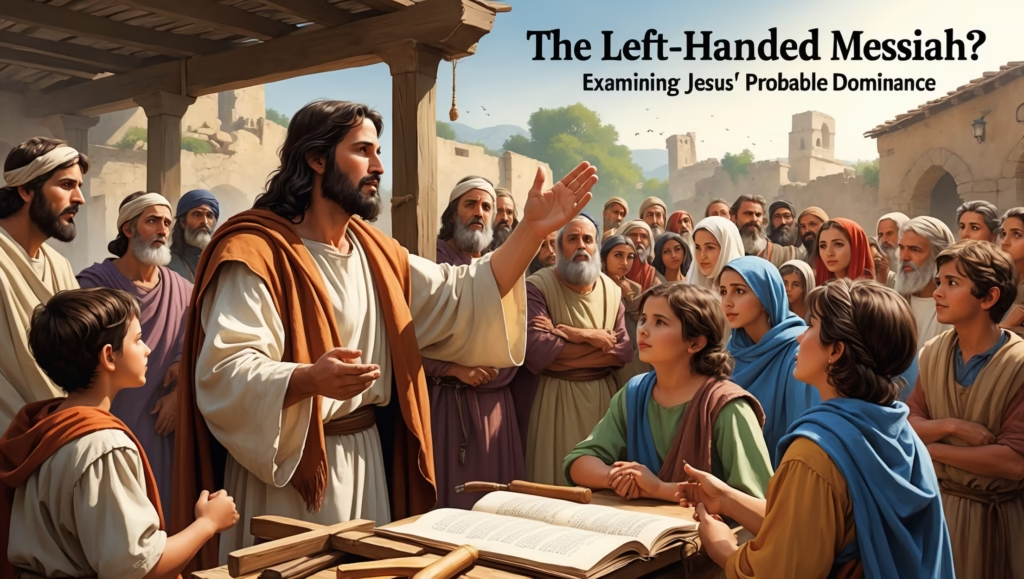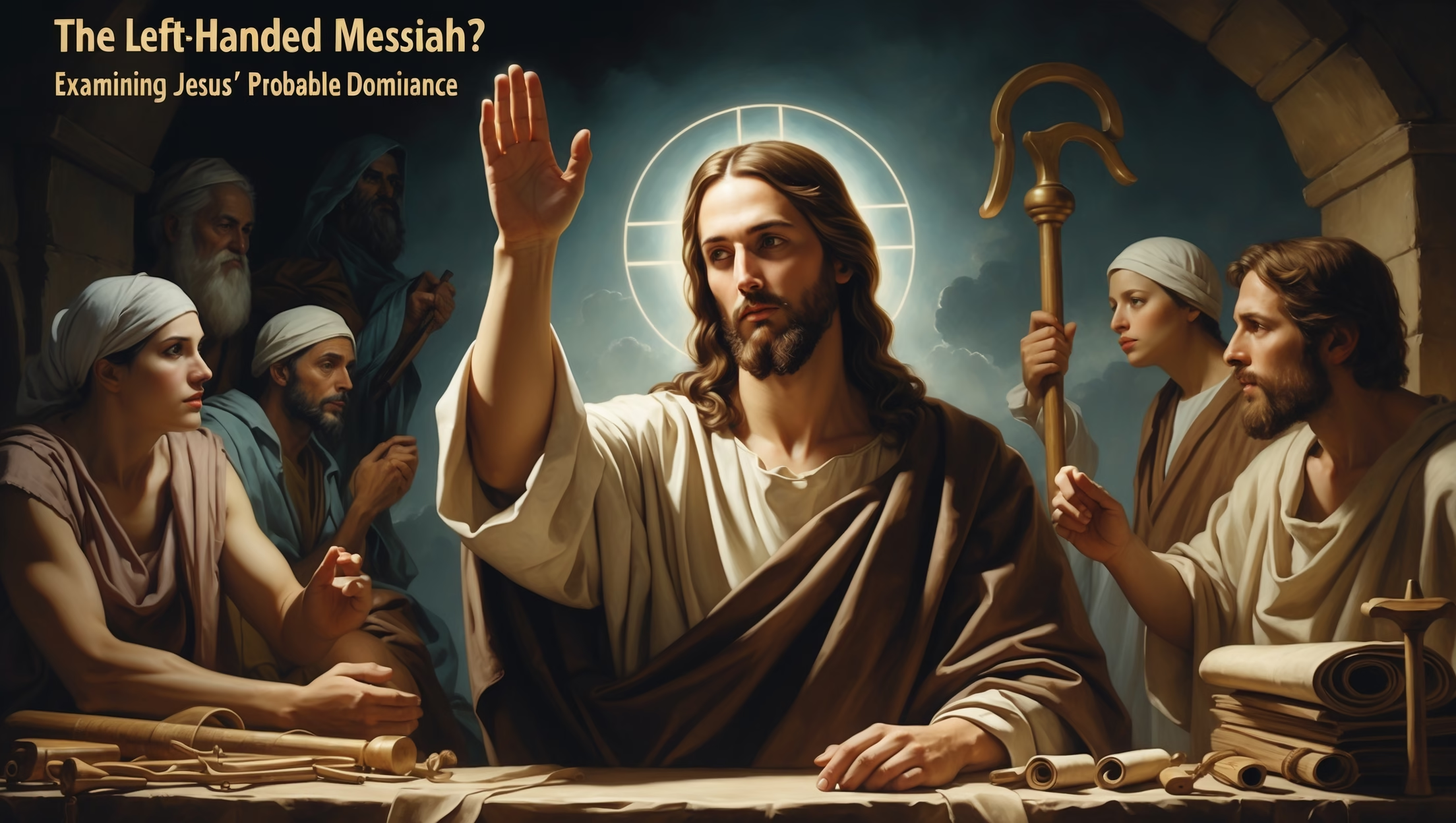How Handedness Shapes Our View of Christ
For centuries, art and tradition have depicted Jesus as a right-handed figure—teaching with His right hand raised in blessing, healing with His right hand extended, and ruling from the “right hand of God.” But what if this image isn’t historically accurate? What if Jesus, the Messiah who upended social, political, and religious expectations, was actually left-handed?
This possibility is more than an academic curiosity. Handedness in the ancient world carried deep symbolic meaning. To reimagine Jesus as left-handed is to open new questions about how culture, theology, and power shaped His image—and how reclaiming His possible left-handedness challenges long-held assumptions.

Archaeological Clues: A Left-Handed World in Nazareth
Archaeological findings from first-century Nazareth provide hints that left-handedness may have been more common—or at least more visible—than traditionally assumed.
- Tool Marks: Excavations show wear patterns on carpentry tools and stone-cutting instruments that suggest usage from the left side. Since Jesus grew up as the son of a carpenter (Mark 6:3), these clues offer at least circumstantial evidence of left-hand dominance in His own trade.
- Right-Handed Bias: In antiquity, society strongly favored right-handedness, often stigmatizing left-handed individuals. This bias meant that left-handed people developed unusual adaptability. If Jesus was left-handed, His physical orientation to tools, writing, and gestures may have stood out in everyday interactions.
- Cultural Observations: The Roman world associated the right hand with honor and the left hand with suspicion or impurity. If Jesus’ movements or habits leaned leftward, His very body would have embodied contradiction to cultural norms—fitting for someone who consistently inverted social expectations.
Biblical Evidence: Hints in the Texts
While Scripture does not explicitly state Jesus’ handedness, several biblical references raise intriguing possibilities.
- “Sheep at the right hand” (Matthew 25:33): Jesus speaks of separating sheep (righteous) to the right and goats (unrighteous) to the left. This reflects cultural associations rather than His personal dominance, yet the emphasis suggests His awareness of handedness symbolism.
- The Crucifixion Wound (John 20:27): The spear wound in Jesus’ right side is peculiar. Roman soldiers typically attacked the exposed side of a body depending on the victim’s stance. If Jesus bore Himself in a way that reflected left-handed dominance, it may explain this unusual angle of injury.
- Old Testament Precedent: Left-handed deliverers existed in Jewish tradition, notably Ehud in Judges 3, who assassinated an oppressor king precisely because his left-handedness made him unpredictable. This echoes Jesus’ identity as a deliverer who upended expectations.
Theological Implications: A Messiah Outside Purity Norms
The early church often portrayed left-handedness as suspicious, if not outright demonic. The Latin word sinister literally means “left,” reinforcing the association of left with danger or impurity.
- Suppression in Tradition: Christian iconography overwhelmingly depicts Christ blessing with His right hand. Theologically, the right was associated with divine favor, while the left was linked with exclusion. A left-handed Christ would have been too radical for early church art to accept.
- Reversing Symbolism: Reclaiming Jesus as left-handed reshapes biblical metaphors. The “left” need not represent rejection, but rather God’s radical embrace of the outcast. In other words, the left hand of Christ could symbolize inclusion, justice, and solidarity with those historically marginalized.
- Challenging Purity Culture: In the first century, the body itself was judged according to purity laws. If Jesus Himself embodied traits viewed as “unclean” or unusual, His ministry to lepers, tax collectors, and sinners gains even deeper resonance.
Modern Impact: Rethinking Art and Theology
Why does this matter today? Because images shape imagination.
- Artistic Representation: Nearly every icon, painting, and sculpture of Jesus reinforces right-handed dominance. Imagining Him left-handed forces us to confront how bias and conformity shape even sacred art.
- Metaphorical Power: In a society where left-handed children are still sometimes pressured to conform, embracing a “left-handed Jesus” reaffirms that God’s image is not bound by cultural norms of purity, dominance, or preference.
- Inclusivity in Theology: From disability studies to gender identity, Christian theology today is expanding to embrace bodies once considered “deviant.” A left-handed Messiah fits into this broader reimagining of Christ as one who identifies fully with human diversity.
Conclusion: A Subversive Gesture
Whether Jesus was left-handed cannot be proven with certainty. But even the possibility disrupts centuries of theological and artistic assumptions. To see Christ as left-handed is to recognize Him as one who embodied the marginal, inverted cultural symbols, and redefined holiness through rejection of purity codes.
In the end, the question of handedness is not trivial. It reminds us that Jesus’ body itself was a scandal to systems of power. Perhaps the true radicality of the gospel is this: whether right-handed or left-handed, Christ blessed with both hands—reaching toward those the world excluded, and turning stigma into sacredness.









